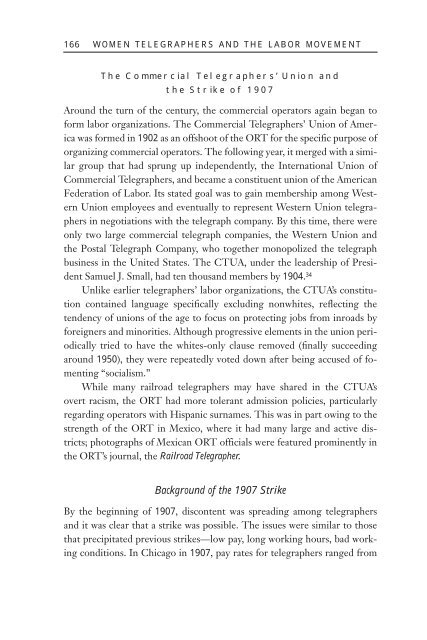My Sisters Telegraphic: Women in the Telegraph Office ... - Monoskop
My Sisters Telegraphic: Women in the Telegraph Office ... - Monoskop
My Sisters Telegraphic: Women in the Telegraph Office ... - Monoskop
Create successful ePaper yourself
Turn your PDF publications into a flip-book with our unique Google optimized e-Paper software.
166<br />
WOMEN TELEGRAPHERS AND THE LABOR MOVEMENT<br />
The Commercial <strong>Telegraph</strong>ers’ Union and<br />
<strong>the</strong> Strike of 1907<br />
Around <strong>the</strong> turn of <strong>the</strong> century, <strong>the</strong> commercial operators aga<strong>in</strong> began to<br />
form labor organizations. The Commercial <strong>Telegraph</strong>ers’ Union of America<br />
was formed <strong>in</strong> 1902 as an offshoot of <strong>the</strong> ORT for <strong>the</strong> specific purpose of<br />
organiz<strong>in</strong>g commercial operators. The follow<strong>in</strong>g year, it merged with a similar<br />
group that had sprung up <strong>in</strong>dependently, <strong>the</strong> International Union of<br />
Commercial <strong>Telegraph</strong>ers, and became a constituent union of <strong>the</strong> American<br />
Federation of Labor. Its stated goal was to ga<strong>in</strong> membership among Western<br />
Union employees and eventually to represent Western Union telegraphers<br />
<strong>in</strong> negotiations with <strong>the</strong> telegraph company. By this time, <strong>the</strong>re were<br />
only two large commercial telegraph companies, <strong>the</strong> Western Union and<br />
<strong>the</strong> Postal <strong>Telegraph</strong> Company, who toge<strong>the</strong>r monopolized <strong>the</strong> telegraph<br />
bus<strong>in</strong>ess <strong>in</strong> <strong>the</strong> United States. The CTUA, under <strong>the</strong> leadership of President<br />
Samuel J. Small, had ten thousand members by 1904. 34<br />
Unlike earlier telegraphers’ labor organizations, <strong>the</strong> CTUA’s constitution<br />
conta<strong>in</strong>ed language specifically exclud<strong>in</strong>g nonwhites, reflect<strong>in</strong>g <strong>the</strong><br />
tendency of unions of <strong>the</strong> age to focus on protect<strong>in</strong>g jobs from <strong>in</strong>roads by<br />
foreigners and m<strong>in</strong>orities. Although progressive elements <strong>in</strong> <strong>the</strong> union periodically<br />
tried to have <strong>the</strong> whites-only clause removed (f<strong>in</strong>ally succeed<strong>in</strong>g<br />
around 1950), <strong>the</strong>y were repeatedly voted down after be<strong>in</strong>g accused of foment<strong>in</strong>g<br />
“socialism.”<br />
While many railroad telegraphers may have shared <strong>in</strong> <strong>the</strong> CTUA’s<br />
overt racism, <strong>the</strong> ORT had more tolerant admission policies, particularly<br />
regard<strong>in</strong>g operators with Hispanic surnames. This was <strong>in</strong> part ow<strong>in</strong>g to <strong>the</strong><br />
strength of <strong>the</strong> ORT <strong>in</strong> Mexico, where it had many large and active districts;<br />
photographs of Mexican ORT officials were featured prom<strong>in</strong>ently <strong>in</strong><br />
<strong>the</strong> ORT’s journal, <strong>the</strong> Railroad <strong>Telegraph</strong>er.<br />
Background of <strong>the</strong> 1907 Strike<br />
By <strong>the</strong> beg<strong>in</strong>n<strong>in</strong>g of 1907, discontent was spread<strong>in</strong>g among telegraphers<br />
and it was clear that a strike was possible. The issues were similar to those<br />
that precipitated previous strikes—low pay, long work<strong>in</strong>g hours, bad work<strong>in</strong>g<br />
conditions. In Chicago <strong>in</strong> 1907, pay rates for telegraphers ranged from

















